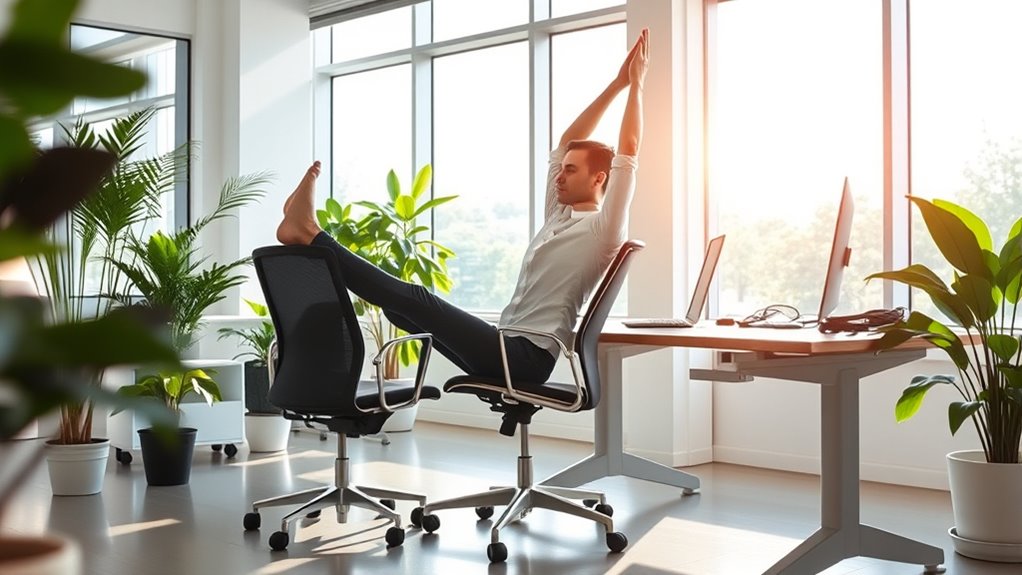To incorporate chair yoga into your workday, start with gentle stretches for your shoulders and chest, like clasping your hands behind your back and lifting your chest. Practice neck tilts and shoulder rolls to ease tension, and incorporate deep breathing to calm your nerves. Remember to adjust your chair for good posture and take brief breaks every hour. Keep going, and you’ll discover simple routines that help you stay energized and reduce stress throughout your workday.
Key Takeaways
- Incorporate gentle stretches that open the chest and shoulders to relieve tension during long sitting periods.
- Use seated chest openers and shoulder rolls to improve posture and reduce muscle stiffness.
- Practice deep breathing exercises to promote relaxation and lower stress levels throughout the workday.
- Adjust ergonomic settings like chair height and foot positioning to support proper alignment and comfort.
- Perform brief, consistent routines every hour to enhance circulation, reduce tension, and boost focus.

If you spend long hours sitting at a desk, incorporating chair yoga into your routine can help reduce tension and boost your energy. Prolonged sitting can lead to muscle stiffness, poor posture, and increased stress levels, but simple chair yoga practices can counteract these effects. To make the most of your sessions, focus on ergonomic tips that support proper alignment, such as adjusting your chair height so your feet rest flat on the floor and your knees are at a 90-degree angle. Maintaining good posture while practicing yoga enhances both comfort and effectiveness, preventing strain and promoting better circulation.
Adjust your chair height for proper alignment and improved comfort during desk yoga.
When practicing chair yoga for stress management, start with gentle stretches that open up your chest and shoulders. For example, seated chest openers, where you clasp your hands behind your back and lift your chest slightly, help counteract the hunching caused by leaning forward at your desk. Incorporate deep breathing exercises during these stretches to calm your nervous system, reducing overall stress. Breathing deeply and slowly can lower cortisol levels, making you feel more centered and relaxed. Focus on maintaining a steady rhythm to maximize stress relief.
You can also include neck and shoulder stretches to alleviate tension from long hours of typing and screen time. Gently tilt your head side to side, holding each stretch for a few seconds, and roll your shoulders backward and forward. These movements help release built-up tension and improve circulation. As you stretch, pay attention to your breathing—inhale as you extend, exhale as you release—to enhance relaxation and stress management. Consistent practice can create a calming effect, helping you feel more focused and less overwhelmed during the workday.
Additionally, incorporating ergonomic principles from other areas can further improve your comfort and reduce strain during your routines. Take a moment to tune into your body, noticing where you hold tension, and adjust your movements accordingly. This mindfulness fosters better ergonomic habits overall, such as sitting upright without slouching, which reduces strain and fatigue. Remember, even brief sessions—just a few minutes every hour—can improve your posture and decrease stress levels. Over time, these small but consistent efforts can contribute to better long-term health and productivity.
Frequently Asked Questions
Can Chair Yoga Help Reduce Work-Related Stress Effectively?
Stress management is essential for maintaining productivity and well-being at work. Chair yoga can effectively reduce work-related stress by encouraging relaxation and mindfulness. It also helps improve posture, which reduces physical tension caused by prolonged sitting. By incorporating simple chair yoga exercises into your daily routine, you can manage stress better and enhance comfort, making your workday more manageable and less stressful overall.
Are Chair Yoga Routines Suitable for All Ages and Fitness Levels?
In the age of enlightenment, it’s clear that chair yoga routines are quite versatile. You’ll find they suit all ages and fitness levels, promoting accessibility and flexibility. Whether you’re a novice or more experienced, these routines adapt easily, making them ideal for diverse needs. You won’t need fancy equipment—just a chair and a willingness to move. So, yes, chair yoga is suitable for everyone, fostering health and wellness across generations.
How Often Should Office Workers Practice Chair Yoga for Best Results?
To get the best results, you should practice chair yoga regularly. Follow frequency guidelines of 3 to 5 sessions per week, allowing your body to adapt and reduce tension. Each session should last about 10 to 15 minutes, making it easy to fit into your workday. Consistency is key, so aim to incorporate short routines daily or every other day for improved flexibility, posture, and stress relief.
Do Chair Yoga Exercises Interfere With Work Productivity?
Imagine your workday as a busy river, flowing steadily. Chair yoga exercises act like gentle bridges, allowing you to pause and cross without stopping the flow. They promote ergonomic benefits and posture correction, enhancing focus. Far from interfering, these small movements keep you energized, helping you stay productive. You’ll find that integrating chair yoga into your routine actually supports your work, making each task smoother and more efficient.
What Safety Precautions Should Be Taken During Chair Yoga Sessions?
When practicing chair yoga, you should prioritize safety by ensuring your ergonomic setup is correct, like adjusting your chair and desk height to avoid strain. Always focus on proper breathing techniques to enhance relaxation and prevent dizziness. Listen to your body, avoid overstretching, and stop if you feel pain. These precautions help you enjoy the benefits of chair yoga while staying safe and comfortable during your sessions.
Conclusion
Think of your workday as a journey across a busy river. With each chair yoga routine, you’re building a sturdy boat, helping you navigate choppy waters with ease. These simple stretches are your anchor, keeping you grounded amid the chaos. So, next time the tide feels high, remember you’ve got the tools to stay balanced and afloat. Embrace these routines, and turn your office hours into a smooth, mindful voyage.









